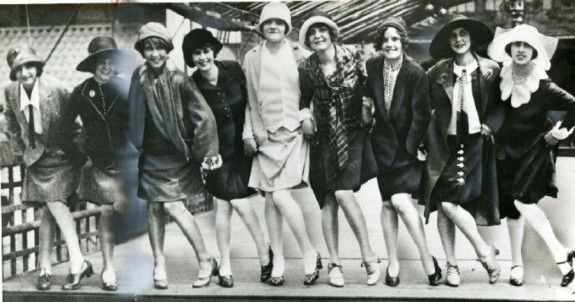
1920's flappers. Photo courtesy the Smithsonian Institute.
Prohibition jump-started the Jazz Age. As songwriter Hoagy Carmichael put it, the 1920s came in "with a bang of bad booze, flappers with bare legs, jangled morals and wild weekends." According to novelist F. Scott Fitzgerald, during Prohibition, "The parties were bigger…the pace was faster…and the morals were looser."
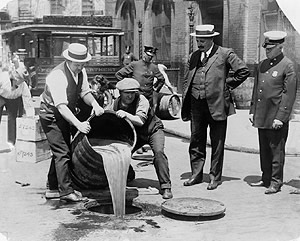
Liquor is removed during a raid in 1920's NYC. Photo wikimedia.
At the stroke of midnight January 16th, 1920, America went dry. There wasn't a place in the country (including your own home) where anyone could legally have a glass of wine with dinner without breaking the law. The 18th Amendment, also known as the Volstead Act, prohibited the manufacture, sale and possession of alcohol in America. Prohibition lasted for thirteen years.
The idea behind Prohibition was to reduce crime and poverty, and generally improve the quality of life in America—by making it impossible for people to get their hands on alcohol. This so-called 'Noble Experiment' was a colossal failure. People drank more than ever during Prohibition, and there were more deaths related to alcohol. No other law in America has been violated so flagrantly—by so many decent law-abiding people. Overnight the law made almost everyone in the country a criminal. Ordinary people hid illegal liquor in hip flasks, false books and hollowed-out canes. In speakeasies, patrons drank bootleg liquor out of tea cups—just in case there was a police raid.
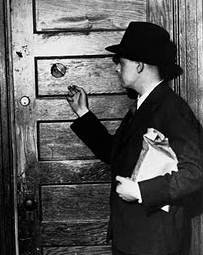
Patron knocks at a speakeasy door during Prohibition. Public domain.
Mob-controlled liquor created a booming black market economy. Gangster-owned speakeasies replaced neighborhood saloons—and by 1925 there were over 100,000 speakeasies in New York City alone. Mob bosses opened plush nightclubs with exotic floor shows and the hottest bands. At Small's Paradise in Harlem, waiters danced the Charleston, carrying trays loaded down with cocktails. Popular stars like Fred and Adele Astaire entertained at The Trocadero. And at the Cotton Club, Duke Ellington led the house band as tap dancer Bojangles Robinson and jazz singer Ethel Waters packed the house. Out in rural America, on Midwestern college campuses, kids drank 'bathtub gin' and danced to the hot jazz of Bix and the Wolverines in lakeside pavilions.
Join us to take a look at the light and dark side of the Prohibition Era on a show we call Speakeasies, Flappers and Red Hot Jazz. The Jim Cullum Jazz Band and their friends celebrate the high-flying party music of the roaring '20s—with tunes from the playing of jazz violinist Joe Venuti, bandleader Duke Ellington and cornetist Bix Beiderbecke.
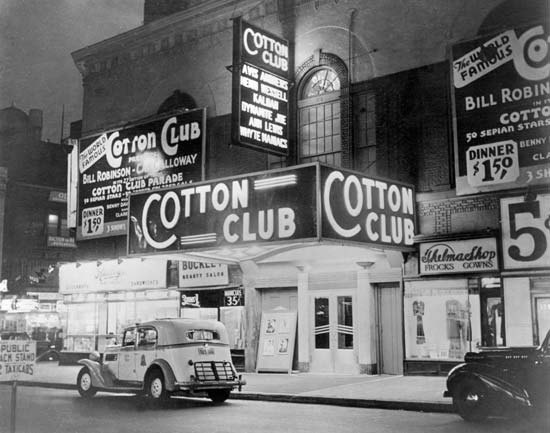
Cotton Club at night. Public Domain.
Only six months after Prohibition became law in 1920, women got the right to vote. Suffragettes were on the front line of this landmark battle, but flappers became the most visible heroines of the Jazz Age.
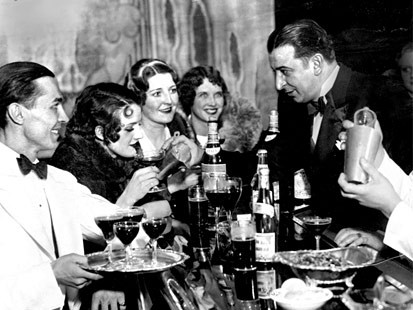
Flappers at a speakeasy bar. Photo in public domain.
The only grown women sporting short skirts and bobbed hair, flappers were easy to spot. They dared to smoke cigarettes and drink cocktails in public. They turned down their hose, powdered their knees and painted their lips bright red. They hung out in speakeasies and nightclubs where they danced the Tango, the Black Bottom and the biggest dance craze of all—the Charleston—with bare arms and legs flying. Parents, teachers and pastors were scandalized by flappers and their boyfriends. These fellows wore knee-length raccoon coats and always kept their hip flasks full of illegal gin. Everyone blamed it on the music. An article in the August 1921 edition of The Ladies' Home Journal posed the question, "Does Jazz Put the Sin in Syncopation?"
Among other crimes, jazz took the rap for being a "Bolshevik element protesting against law and order"—and "an influence for evil in society."
The real issue seemed to be that jazz dances inspired young women to leave their corsets at home—and loosen up.
Prohibition was a joke to many Americans. So many speakeasies flowed with bootleg booze that New York was known as the "City on a Still."
.jpg)
Texas Guinan. Photo courtesy texasguinan.blogspot.
One of the stars of the speakeasy racket was a brassy, bold, peroxide blond who called herself "Texas" Guinan. She'd been an actress in silent film westerns, a bare-back circus rider, and a singer in vaudeville before fronting speakeasies for the mob. Famous for greeting her patrons with the line "Hello, sucker!" her clubs were raided and padlocked by the police so often that she wore a necklace made of padlocks as her trademark. Another trademark was her chauffeured armored car.
Prohibition broke down old social barriers. In many New York speakeasies rich people and ordinary folks, men and women all rubbed shoulders. They had two goals in common—getting their hands on the best illegal liquor around, and avoiding a ride to the police station in a paddy wagon.
The stock market crash of 1929 signaled the end of the party.
The Roaring 20s came to a close in economic chaos, and the lighthearted atmosphere of the Prohibition Era fizzled out with the end of the decade.
In 1931 Jazz Age cornetist Bix Beiderbecke died alone in a small hotel in Manhattan at the age of 28, destroyed by alcohol. The same year Al Capone landed in jail—for income-tax invasion, though not murder or racketeering. In 1933 Prohibition was officially rescinded.
Riding down Fifth Avenue in Manhattan, F. Scott Fitzgerald wept at the loss of what was to him a magical era. He said, "I had everything I wanted and knew I would never be so happy again."
Photo credit for home page teaser image: 1920's flapper.
Text based on Riverwalk Jazz script by Margaret Moos Pick ©2005

